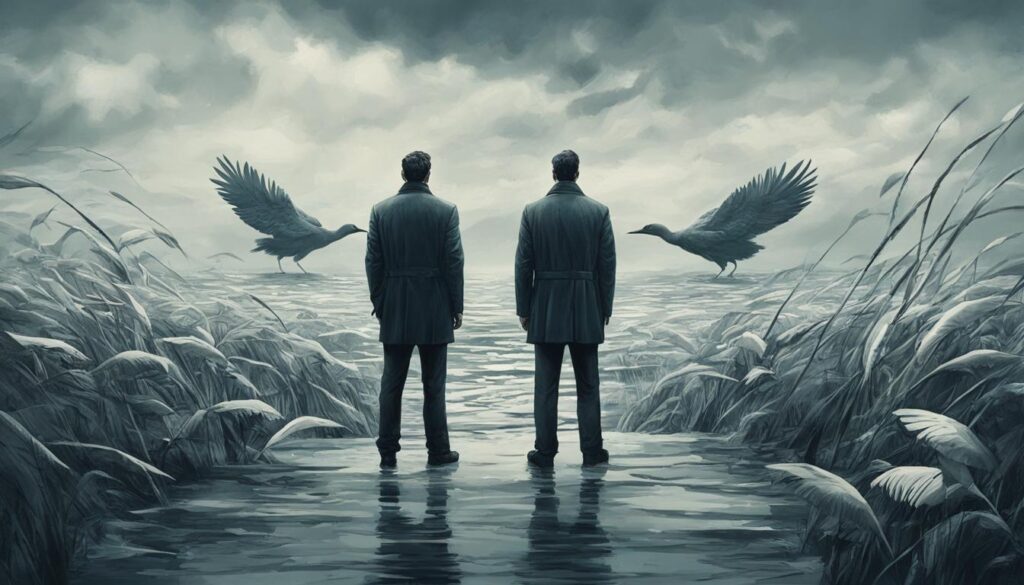If you are looking for a thought-provoking read that explores complex human themes, then “I Am The Wind” by Jon Fosse is a must-read. This novel is a profound exploration of the human psyche and the relationships we form, as well as the themes of isolation and connection.
In this article, we will delve into the book summary of “I Am The Wind” and provide essential information about Jon Fosse, the author of this acclaimed novel. So, let’s begin our journey into the world of Jon Fosse’s “I Am The Wind”.
About Jon Fosse
Jon Fosse is a prominent Norwegian author celebrated for his unique literary style and impactful works. With over 30 published books and many stage plays, his writing has captivated audiences worldwide. Fosse was born in 1959 in Strandebarm, Norway, and began his career as a playwright in the early ’80s. Over time, he moved to poetry and then to prose, garnering critical acclaim and numerous awards along the way. His works often revolve around the themes of human relationships, vulnerability, and silence. Notably, Fosse’s play Night Sings Its Songs was the first original Norwegian work to be produced at London’s National Theatre, cementing his international reputation as a talented writer.
Fosse has gained international recognition for his unique writing style, which often features minimalistic and elliptical language, and a keen eye for subtle nuances in human behavior. His works have been translated into almost 40 languages, making him one of the most widely read and respected Nordic authors of his generation. Fosse’s contributions to Norwegian literature have earned him numerous accolades, including the Nordic Council Literature Prize and the Henrik Steffens Prize. His impact on Nordic literature and culture is undeniable, and his work continues to inspire and captivate readers around the world.
Plot Overview
“I Am The Wind” by Jon Fosse is a hauntingly beautiful novel that explores the depths of human experience. The plot centers around two nameless men, identified only as One and Two, who are sailing together on a boat. As they journey across the vast sea, they engage in deep conversations about life, love, and death, revealing their hopes, fears, and regrets. Along the way, they encounter various obstacles and challenges that test their bond and showcase the fragility of human connection.
The narrative arc of the story is circular, beginning and ending with the same image of the men in the boat. However, their journey is not linear, as the story often shifts between past and present, dream and reality. This non-linear structure adds to the dreamlike quality of the novel, inviting the reader to delve into the characters’ subconscious and emotional landscapes.
“He starts to row again. The oars creak in the rowlocks. The men make little headway. There is a lot of water to cross. There is a long way to go. But they are patient, they have time.”
Themes Explored
In “I Am The Wind,” Jon Fosse explores the themes of human connection and isolation with poignant depth and sensitivity. Through the interactions and inner thoughts of his two main characters, the play highlights the ways in which isolation can lead to an intense yearning for human connection, and how the inability to form meaningful relationships can exacerbate feelings of loneliness and despair.
The characters of the play, simply known as “He” and “I,” are presented as two lost souls adrift in the vast expanse of the ocean. As they navigate the treacherous waters, battling the elements and their own inner demons, they come to realize that they are each other’s only hope for sustenance and survival.
“We are at sea. We don’t have anything to eat. Nothing. We have nothing.” – He
Their struggle to connect and communicate with one another is representative of the universal desire for human connection, while their isolation in the vast ocean symbolizes the profound sense of loneliness and detachment that many people experience in their lives.
As the play unfolds, the audience witnesses the characters’ tentative attempts at bonding and how these connections are easily broken. The characters’ inability to truly connect leads to a deeper sense of isolation, that manifests in their actions and dialogue.
“I am lonely after all this time,” “We don’t talk because we don’t know how to talk. We just make sounds.”
The play presents a stark and moving portrayal of the profound impact that isolation can have on the human psyche. Through his exploration of this theme, Jon Fosse highlights the importance of human connection and the devastating consequences that can result from its absence.
Key Characters
“I Am The Wind” by Jon Fosse centers around two characters identified only as “He” and “I.” The two characters are incredibly close friends who set out on a sailing trip, all the while talking and contemplating their past experiences and relationships.
“He” is depicted as a middle-aged man carrying deep wounds from his past relationships, while “I,” a younger man, tries his best to help “He” overcome his inner demons.
The characters are portrayed in a way that puts an emphasis on their emotional state rather than their physical descriptions. They remain largely undefined throughout the story, leaving readers to focus on the experiences and events they encounter.

“I Am The Wind” showcases the complexity of friendship and the ways in which one can attempt to process trauma while also exploring themes of isolation and human vulnerability, all through the lens of “He” and “I’s” experiences.”
Writing Style
Jon Fosse’s writing style in “I Am The Wind” is characterized by a minimalist approach that emphasizes the essentials and leaves ample room for interpretation. Fosse employs repetition, elliptical sentence structures, and sparse dialogue to create a meditative, introspective atmosphere that invites the reader to engage with the themes explored in the story.
One of Fosse’s signature techniques is the use of fragmentary, stream-of-consciousness narration, which captures the fleeting, elusive nature of human thought and emotion. This style creates a sense of intimacy between the reader and the characters, allowing the reader to inhabit the characters’ inner worlds and understand their motivations on a deep, intuitive level.
“The dialogue is almost musical in its repetition, with a kind of understated intensity that makes the occasional outburst all the more striking” – The Guardian
Fosse’s prose is also rich in sensory detail, which he uses to evoke the mood and atmosphere of the story’s coastal setting. The sea and the sky are recurring motifs that function as a backdrop to the characters’ inner journeys, echoing their sense of yearning and longing for connection.
Overall, Jon Fosse’s writing style in “I Am The Wind” is a testament to the power of simplicity and suggestion. Through his spare, poetic prose, he creates a haunting, deeply affecting portrait of two friends struggling to connect amidst the vastness of the natural world.
Reception and Impact
Since its publication, I Am The Wind has received widespread critical acclaim for its poignant exploration of human connection and isolation. The novel has been praised for its poetic language and unique narrative style, cementing Jon Fosse’s reputation as a masterful storyteller.
The novel has been translated into multiple languages, expanding its reach and impact on a global scale. It has been the recipient of numerous literary awards, including the prestigious Nordic Council Literature Prize.
Through its lyrical storytelling and profound themes, I Am The Wind has left a lasting impression on the literary world, inspiring readers to reflect on the nature of human relationships and the isolation that often accompanies them.
Cultural Significance
The book “I Am The Wind” by Jon Fosse holds deep cultural significance, addressing important societal issues and themes that resonate with readers from all walks of life.
Through the story of two friends drifting aimlessly on the ocean, Fosse explores the themes of loneliness, isolation, and the painful struggle for human connection.
The novel has been praised not only for its literary merit but also for its cultural significance, with many critics pointing to its universal appeal and timely message.
“Fosse’s masterful portrayal of the human condition in the face of loneliness and isolation speaks to the heart of today’s society, making ‘I Am The Wind’ an important and relevant work of fiction for our times.”
The book’s impact has been felt throughout the literary world, with many citing it as a defining work of contemporary fiction. Its themes have also influenced various cultural mediums, including music, film, and visual arts.
“I Am The Wind” continues to inspire and provoke thought, solidifying Jon Fosse’s place as one of the great literary voices of our time.
Critical Analysis
After a thorough examination of “I Am The Wind,” it is evident that Jon Fosse’s unique writing style has successfully conveyed the complex themes of human connection and isolation. The characterization of the two unnamed characters adds to the enigmatic effect, with their dialogue being the driving force of the narrative. Fosse’s use of repetition serves to emphasize the characters’ emotions, leading to a sense of unease and discomfort in the reader.
However, despite its strengths, “I Am The Wind” may be found lacking in plot development. The lack of a clear plot may leave some readers feeling unsatisfied and struggling to find meaning in the story. Additionally, some readers may find Fosse’s style to be pretentious and alienating.
I Am The Wind is a heart-wrenching, thought-provoking read that asks readers to examine the nature of human relationships and the isolation we all face.
Overall, “I Am The Wind” is a complex novel that requires critical analysis to fully appreciate its deeper meanings. While some readers may find it challenging, others may connect with the themes explored in the novel. Despite its flaws, Jon Fosse’s unique writing style and poignant message make “I Am The Wind” a worthy addition to any critical reader’s list.
Conclusion
In summary, “I Am The Wind” by Jon Fosse is a poignant novel that delves into the complex themes of human connection and isolation. Through the unique writing style and literary devices employed by Fosse, readers are taken on a journey that explores the intricate relationships between the main characters and their struggles with loneliness and disconnection.
Overall, this book offers a compelling narrative that is sure to captivate readers and leave a lasting impression. Its critical reception and cultural significance further emphasize its importance in the literary world. For anyone looking for a thought-provoking read that is both poignant and evocative, “I Am The Wind” is definitely worth checking out.
With its rich character development, intricate plot, and beautiful prose, this book is a must-read for any fans of contemporary literature or those interested in exploring the themes of human connection and isolation. In conclusion, “I Am The Wind” is a masterpiece that highlights the enduring power and impact of storytelling through its powerful and heartfelt message.
Book Summary: “I Am The Wind” by Jon Fosse is a powerful novel that explores the complex themes of human connection and isolation through a unique writing style and rich character development.



